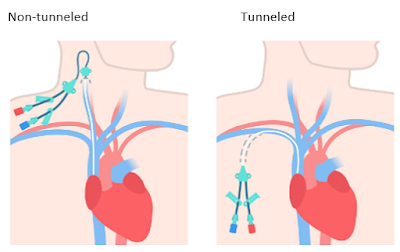Entry sites for CVCs can include the subclavian, jugular, or femoral vein, or the inferior vena cava. To be considered a CVC, the tip of the catheter must end in one of these locations:
o Superior or inferior vena cava
o Right atrium
o Subclavian, brachiocephalic (innominate) or iliac veins
Source: https://www.ciamedical.com/insights/differences-tunneled-vs-non-tunneled-catheter/
A further determination of the CPT code to be assigned is the age of the patient. There are two separate CPT codes to describe the insertion of a non-tunneled CVC procedures based on whether the patient is younger than 5 years of age (36555), or 5 years and older (36556). For example, if a non-tunneled CVC is inserted for a 4 ½ year old, then the code assignment would be 36555.
Central venous catheters that are tunneled are further distinguished by if they are accompanied by a port or pump or neither. If neither a pump or port is used, again, age will determine which code to assign (36557 or 36558).
With a port-a-cath, the port is implanted in a small pocket under the skin and the catheter is tunneled to the vein and then to one of the termination points listed above (36560 or 36561). The pumps are inserted in the same way but are not distinguished by age (36563).
If a CVC placement necessitates 2 catheters each with a separate access site, one of two codes could be assigned, 36565 without port/pump, or 36566 with port.
It is permissible to also assign imaging guidance codes with the codes for CVC insertion if the guidance facilitates access to the entry site and/or obtaining the termination point with the catheter.
If a central venous access catheter needs repaired, 36575 will be assigned if there is not an associated port/pump. If there is a port/pump, then the repair code will be 36576. Repositioning of a CVC catheter already in place done under fluoroscopic guidance is coded to 36597.
When only the catheter of a CVC with a port/pump needs replaced, the CPT code to be assigned is 36578. Occasionally, the entire CVC must be replaced, and in this case, CPT codes differentiate between whether or not the CVC is tunneled and if it is replaced using the same venous access site (36580-36583). If, however, a CVC is removed and replaced through a different access site, the coding professional should assign codes for both the removal and the insertion.
The removal of a tunneled CVC is coded based on whether or not there is a port/pump. Assign CPT code 36589 for those CVCs without a port/pump, and 36590 for those CVCs with a port/pump. Non-tunneled CVCs do not have a CPT code for their removal.Now, light has been shed on coding central venous access procedures.
Click HERE to take an assessment on this material.
About the Author
 Dianna Foley, RHIA, CCS, CHPS, CDIP, is
OHIMA's Education Coordinator. Dianna has been an HIM
professional for over 20 years. She progressed through the ranks of coder,
department supervisor, and department director, to her current role as a
coding consultant.
Dianna Foley, RHIA, CCS, CHPS, CDIP, is
OHIMA's Education Coordinator. Dianna has been an HIM
professional for over 20 years. She progressed through the ranks of coder,
department supervisor, and department director, to her current role as a
coding consultant. She previously served as the program director for Medical Coding and HIT at Eastern Gateway Community College. Dianna earned her bachelor's degree from the University of Cincinnati and holds RHIA, CHPS, CDIP and CCS certifications. She is an AHIMA Approved ICD-10-CM/PCS Trainer and is a presenter on coding topics at the national, state, and regional levels. Dianna mentors new AHIMA members and also provides monthly educational lectures to coders and clinical documentation specialists.



